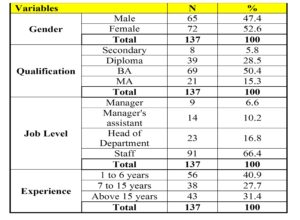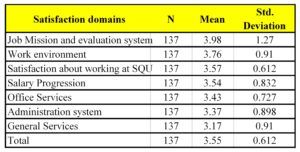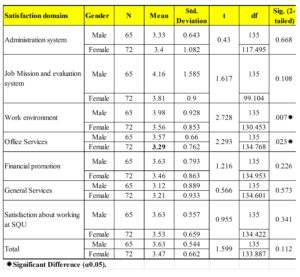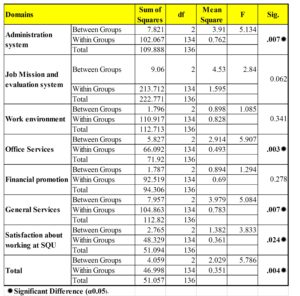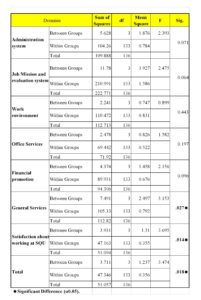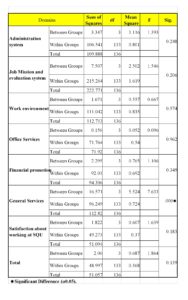Discussion
The results of the study indicated that Sultan Qaboos University administrative staffs were satisfied with their job. This result could be due to the fact that the university is extremely concerned about providing a positive working environment to make its employees happier and more productive and about reducing turnover rates. It also could be because SQU is the only governmental university and it is highly supported by the government and under the eye of the government to maintain its quality and reputation as it carries the name of His Majesty. The university buildings and facilities have their effect on the levels of job satisfaction where the design of the university was well structured to provide a suitable working environment. Moreover, Yahy (2012) stated that it also could be due to the religious and cultural aspects which encourage the staff to be more positive in their work and to cooperate with others.
The satisfaction is a result of the university policies to maintain the quality of its products and services to compete with another private university which has become recently a competitor of SQU. It also is due to accelerated development in services such as new buildings which provide more offices, introducing new services for staff, and introducing all services electronically. It also is due to the service evaluation system which allows staff to evaluate the quality of all provided services through online questionnaires every year, which has led to the development of many of these services. The satisfaction is furthermore a result from the high increase in the staff salaries which took place in January 2014 and expectation of further increases in July 2014. The university policies were effective in raising the level of job satisfaction as literature showed a relationship between job satisfaction and work environment, salary, and relationships with colleagues (Küskü, 2003), and the correlation between job satisfaction and promotion (Ellickson and Logsdon 2002, Peterson, et al., 2003).
Based on the results, SQU, according to the literature, has achieved one of the main elements of an institution’s success, which is employees’ satisfaction (Freeman, 2005). Such levels of satisfaction for SQU are illustrated in Table 2. According to Clark (2001); Shields and Ward (2001) positively reflected on SQU staff’s working behavior, loyalty and their interest in working instead. It will also lead to strengthening the relationships between staff, increasing cooperation, motivation and work quality and their performance (Bruce and Blackburn, 1992; Fajana 2002).
The results also showed that job satisfaction was affected by gender. The finding of this study supports the results of some previous studies which showed that males had higher levels of job satisfaction than females (McIntyre and McIntyre, 2010). This difference is mainly in working environment and office services which could be due to the fact that some females share offices with male staff, which may not be comfortable for them. It could also be because females feel greater pressure in relation to work, and they were less trusted by their leaders. They were also less trusted because of the speed of providing service.
In this research, respondents with lower job experience showed higher job satisfaction levels. This result contradicts with the literature which showed that those who have more experience have higher levels of job satisfaction (Mathieu and Zajac, 1990; Meyer et al., 2002). This result could be because those who have more experience have higher ambitions for getting better services were interested in developing administration systems. A study by Gesinde and Adejumo (2012) indicated that there was significant positive relationship between age and work experience and job satisfaction. Whereas, in a contradictory study by Hong, Hamid and Salleh (2013) indicated that age factor negatively affects the employee job satisfaction. The results may benefit organizations in enhancing overall job satisfaction and in empathizing organizational issues such as high turnover (Kerber and Campbell, 1987).
The result also revealed that administrative staff job satisfaction was affected by their qualification and job level. This result could be due to the high expectations of those who hold higher degrees and higher job level compared to those who hold lower degrees and lower job level. Such results could be due to comparisons in which these employees compare the services provided with other institutions which provide better services. It also could be due to the fact that the service provided is less than their expectations according to their qualification and working position.
Study Limitations, Further research and Conclusion
Limitations
The limitations of this study were as follow:
1. The data were limited to Sultanate Oman.
2. This research is limited to only one governmental university Sultan Qaboos University
3. Limited to non-academic staff — The research was collected solely from administrative employees of Sultan Qaboos University in Oman.
Further Research
Therefore, further study, in expanding the sample size of administration staff to be greater than the number who participated in this study is crucial in order to verify the generalizability of the findings to a larger population of Sultan Qaboos University. A more balanced ratio of men to women responses in this study could possibly provide more significant results to further understand perceived job satisfaction of males and females in relation to turnover and job satisfaction. Additionally, the study should also focus on comparisons between faculty members and administrative staff to measure the job satisfaction and turnover.
Conclusion
The study indicated that Sultan Qaboos University administrative employees were satisfied with their job and with working in a good workplace environment, which made the staff more productive and secure, and thus reducing the turnover rate. Furthermore, SQU believes that their staff is the number one asset, with the highest degrees of competence, integrity and professionalism. Although SQU instills in its people the principles of entrepreneurship and decision-making, the university needs to stress the positive aspects of job satisfaction and sort out the negative aspects which may affect staff job satisfaction currently or in the future. Furthermore, the Omani culture and the loyalty aspect inspire the workforce to be more confident in their job environment and to collaborate. Nevertheless, the job satisfaction may also result from the enhancement of the employees’ salaries during the data collection time of this study.
Acknowledgements
The researchers thank all the staff who responded to their study’s questionnaire and all the staff who helped them to distribute and gather questionnaires from different departments. They also appreciate the comments provided by Dr Nehal Elnaggar from Royal University for Woman in Bahrain and Dr Ebtisam Al-Alawi from Brunel University in the UK and Ms Sara Al-Bassam from Arabian Gulf University in Bahrain.
(adsbygoogle = window.adsbygoogle || []).push({});
References
1. Al-Alawi, A. I. and Al-Alawi, E. I. (2014). “Measuring Occupational Stress among Management Information Systems Workers and Users in the Financial Services Sector: The Case of Bahraini Bankers”, International Journal of Scientific and Research Publications, 4(8) ISSN 2250-3153.
Google Scholar
2. Alam, S., Sameena, R. and Puja, A. (2012). “Identification of Variables Affecting Employee Satisfaction and Their Impact on the Organization”, IOSR Journal of Business and Management. 5(1) 32-39.
Google Scholar
3. Brown, D. and Sargeant, M. (2007). “Job satisfaction, organizational commitment, and religious commitment of full time university employees”,Journal of Research on Christian Education, 16, 211-241.
Publisher – Google Scholar
4. Bruce, W. M., and Blackburn, J. W. (1992) . Balancing job satisfaction and performance. Westport, CT: Quorum Books.
5. Carpitella, Bill. (2003). Make residential construction the industry of choice. Professional Builder, Oct 2003.
6. Clark, A.E. (2001). “What Really Matters in a Job? Hedonic Measurement Using Quit Data”,Labour Economics, 8, 223-242.
Publisher – Google Scholar
7. Ellickson, M. and logsdon , K. (2002). “Determinants of Job satisfaction of municipal government employees”, Public personnel management, 31(3), 343 — 358.
Publisher – Google Scholar
8. Fajana, S. (2002). Human Resource Management: An Introduction. Lagos: Labofin and Company.
9. Kusku, F. (2003). “Employee satisfaction in higher education: the case of academic and administrative staff in turkey”, Career Development International, 8 (7), 347-356.
Publisher – Google Scholar
10. Freeman, S. (2005), “Employee satisfaction: The key to a successful company”, [online], [Retrieved on March 15, 2016], http://library.lp.findlaw.com/articles/file/00301/008927/title/Subject/topic/Employment.
11. Gesinde, A. M., and Adejumo, G. O. (2012). “Effects of Age and Work Experience on Job Satisfaction of Primary School Teachers: Implications for Career Counseling”. International Journal of Asian Social Science, 2(3), 302-309
Google Scholar
12. Harter, J., Schmidt, F. L., and Hayes, T. (2002). “Business-unit level relationship between employee satisfaction, employee engagement, and business outcomes: A meta-analysis”, Journal of Applied Psychology, 87, 268-279.
Publisher – Google Scholar
13. Hong, L. C., Hamid, N. I. N. A., and Salleh, N. M. (2013). “A study on the factors affecting job satisfaction amongst employees of a factory in Seremban, Malaysia”. Business Management Dynamics, 3(1), 26-40.
14. Kerber, K. W., and Campbell, J. P. (1987). Job satisfaction: Identifying the important parts among computer sales and service personnel. Journal of Business and Psychology, 1(4), 337-352.
Publisher – Google Scholar
15. Leckie Gloria J. and Brett, Jim. (1997). Job satisfaction of Canadian University Librarians: A national survey.College and Research Libraries 58, January, 31-47.
Publisher – Google Scholar
16. Locke, E. A. (1976). The nature and causes of job satisfaction. In M. D. Dunnette (Ed.), Handbook of industrial and organizational psychology (pp. 1297—1349). Chicago: Rand McNally.
17. Lofquist, L. and Dawis, R. (1991). Essentials of person environment correspondence counselling, University of Minnesota Press. Minneapolis.
Google Scholar
18. Lu, H., While, A. E., and Barriball, K. L. (2005). “Job satisfaction among nurses: A literature review”, International Journal of Nursing Studies, 42, 211—227.
Publisher – Google Scholar
19. Luthans, F. (1994). Organizational Behavior. New York: McGraw-Hill.
20. Ma, C. C., Samuels, M. E., and Alexander, J. W. (2003). “Factors that influence nurses’ job satisfaction”. Journal of nursing Administration, 33(5), 293-299
Publisher – Google Scholar
21. Mathieu, J. E. and Zajac, D. M. (1990), “A review and meta-analysis of the antecedents, correlates, and consequences of organizational commitment”, Psychological Bulletin, 108, 171-194.
Publisher – Google Scholar
22. Mclntyre, T. M., and Mclntyre, S. E. (2010). “Measuring job satisfaction in Portuguese health professionals: Correlates and validation of the job descriptive index and the job in general scale”, International Journal of Selection and Assessment, 18, 425-431.
Publisher – Google Scholar
23. Meyer, J. P., Stanley, D. J., Herscovitch, L. and Topolnytsky, L. (2002).“Affective, continuance, and normative commitment to the organization: A meta-analysis of antecedents, correlates, and consequences”, Journal of Vocational Behaviour, 61, 20-52.
24. Nguyen, N., Taylor, J. and Bradley, S. (2003).“Relative pay and job satisfaction: some new evidence”,Working paper 045, Department of Economics, Lancaster University Management School.
Google Scholar
25. Olorunsola, E. (2010). “Job Satisfaction and gender factor of administrative staff in South West Niggria University”,Contemporary Issue In Education Research, 3(10) 51 — 56.
Publisher – Google Scholar
26. Peterson, D. K., Puia, G. M and Sues, F. R. (2003). “YoTengo La Cainisela (I Have the Shint On)’’, “An Exploration of Job satisfaction and Commitment among Workers in mexico”,Journal of Leadership and Organizational studies, 10(2), 73 — 88.
Publisher – Google Scholar
27. Rita, B and Irena, B. (2012). “Determinations of different group employees’ job satisfaction: Litunia’s University case”, Human Resources Management and Ergonomics, I, 6 — 17.
28. Ryan, E. and Marvin, P. (2006). “Examining Herzberg’s theory: improving job satisfaction among non-academic employees at a university”, Research in Higher Education, 48 (2), 229 — 250.
29. Smith, P. C. and Stanton, J. M. (1999). “Perspectives of the measurement of job attitudes: The Longview”, Human Resource Management Review, 8(4), 367-386.
Publisher – Google Scholar
30. Shields, M. A. and Ward, M. (2001). “Improving nurse retention in the National Health Service in England: The impact of job satisfaction on intention to quit”, Journal of Health Economics, 20, 677-701.
Google Scholar
31. Spector, P.E. (1997). Job Satisfaction: Application, Assessment, Causes and Consequences. Thousand Oaks, CA Sage.
Google Scholar
32. Toloposky, A. (2000). What every supervisor should know. New York: McGraw-Hill.
33. Tulen, S. and Serife, Z. (2012). “Have gender differences in job satisfaction disappeared? A study of Turkish universities in North Cyprus, African”, Journal of Business Management 6(1), 250-257.
Google Scholar
34. Yahy, M. (2012). “Value of work in Islam and its contribution in sustainable development”, International Symposium about sustainable development facilities in Islamic Economic, 3-4 December 2012 [online], [Retrieved June 12, 2014]. http://iefpedia.com/arab/wp-content/uploads
35. Trevor, C. O., Reilly, G., and Gerhart, B. (2012). “Reconsidering pay dispersion’s effect on the performance of interdependent work: Reconciling sorting and pay inequality”. Academy of Management Journal, 55(3), 585-610.
Google Scholar
36. Pfeffer, J., and Davis-Blake, A. (1992). “Salary dispersion, location in the salary distribution, and turnover among college administrators”. Industrial and labor relations review, 45(4), 753-763.
Google Scholar



